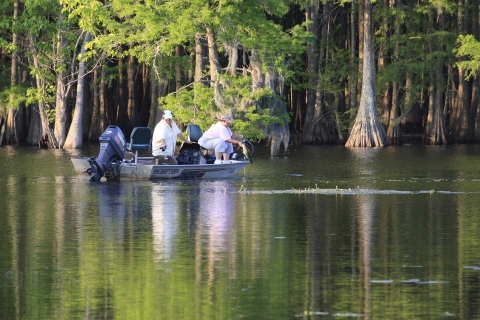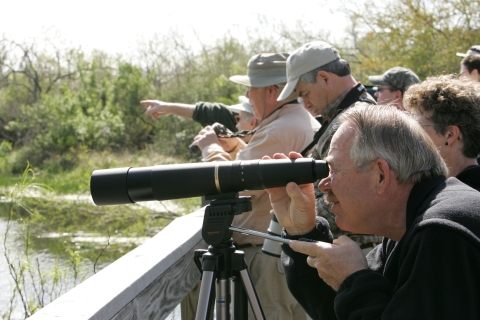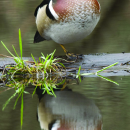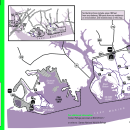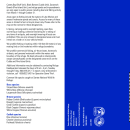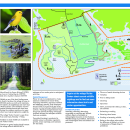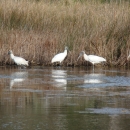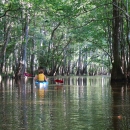Visit Us
The refuge is located on the north shore of Lake Marion, the largest lake in South Carolina. It is a major wintering area for ducks and geese, as well as a nesting and stopover area for neo-tropical migratory birds, raptors, shore birds, and wading birds that include the threatened Wood stork. Numerous other species of wildlife are indigenous to this area. Public use opportunities at the refuge include a Visitor Center with educational exhibits, native pollinator garden, walking trails, and an auto tour route.
The Visitor Center houses wildlife exhibits such as waterfowl, alligators, and neo-tropical songbirds. The Center also includes a deck overlooking Scott's Lake with a view of the Santee Indian Mound across the water. The Santee Indian Mound dates back over 1000 years, a mound used as a substructure of a ceremonial temple and also as a burial site. After the Native Americans dispersed from the banks of the Santee River in the early 1700s, the mound was used for a second purpose nearly 70 years later, as a British outpost during the Revolutionary War. Mounted binoculars on the deck give visitors a view of the lake landscape and birds on the water.. You can pick up binoculars and backpacks (containing field guides and other materials to aid you in what you might discover) that we will loan you for free.
For adults, the Visitor Center has information about the refuge such as species lists, interpretive guides, maps, and hunting/fishing permits. We also have literature and information on other local area attractions, South Carolina Refuges, and wildlife publications. There is also a wildlife observation log that visitors and staff record recent sightings on the refuge.
For children, the Center has a "Kid's Corner" with crafts, coloring books, and field guides for children. The Wildlife exhibits give children an up-close look at some of the many "wild" residents of Santee National Wildlife Refuge. A touch table allows children (and adults) to see, touch, and feel different objects like turtle shells, feathers, antlers, and various other bio-facts from local wildlife, including a very large alligator skull.
For families, the Center is a great place for families to come to find out about trails on the refuge, things to do, and what has been sighted recently on the refuge. Checking out a "loaner backpack" and going out to hike a trail along Scott's Lake is a great way for families to spend a day on the refuge. Stop by the visitor center and find out more information about these opportunities.
Fishing, birding, hiking, wildlife observation, photography, and hunting opportunities abound for visitors at Santee NWR!
Activities
Santee NWR is open daily from dawn until dusk with vehicular access on the Cuddo Unit limited to the following times:
October 1 – February 28: 7 am – 5 pm
March 1 – September 30: 6 am – 8 pm
An automatic gate on the Cuddo Unit controls hours of vehicular access to minimize disturbance to wildlife. Please note the Cuddo unit is closed on Mondays.
Wildlife observation is one of the primary public uses of National Wildlife Refuges. Getting out and learning to identify wildlife species in their native habitat can be very exciting and rewarding. The refuge has 2 observation towers (Bluff Unit and Dingle Pond Unit) as well as several other areas that are great for spotting wildlife. It is recommended that visitors bring a pair of binoculars and a field guide when visiting the refuge, but in case you forget, stop by the visitor center, and take advantage of the loaner program the refuge has available.
The four units on the refuge each offer a variety of outdoor recreation activities for the refuge visitor. The Visitor Center and the Santee Indian Mound-Fort Watson site are found at the Bluff Unit. Hiking the Wright’s Bluff Nature Trail gives visitors a chance to observe a variety of wildflowers, songbirds, small mammals and reptiles. The north side of this trail, along Cantey Bay, is a great place to observe wading birds, Canada Geese, shorebirds and other wetland species. An observation platform and a 15-foot observation tower provide opportunities to view wildlife.
Home to a 350 acre Carolina Bay, Dingle Pond is a unique “depressional” wetland typically fed by rain and natural springs. This area is home to a variety of wildlife species some of which are unique to Carolina Bays. A one-mile dirt trail is open for hiking and provides access to an observation tower overlooking the bay.
The Pine Island and Cuddo Units provide the greatest diversity of habitats of the four units. Visitor access to Pine Island is limited to foot and bicycle traffic on approximately 4 miles of roads. A primitive boat launch area is provided for small boats, canoes and kayaks. A 7.5 mile wildlife drive and 5 miles of hiking trails on the Cuddo Unit give visitors great opportunities for wildlife observation. Turkey, white-tailed deer and very large alligators are common. An additional 8.5 miles of hiking/bicycling trails let visitors explore fields, woods and wetlands, and there are over 8 miles of canoe and kayak trails. An automatic gate on the wildlife drive controls the hours of access to minimize disturbance to wildlife.
Some hiking/biking trails are closed during November 1 – March 1 for the waterfowl sanctuary period. All trails are closed during the deer hunting season. Please call the Headquarters at 803.478.2217 for closures.
Birding is a popular activity, especially during the Spring and Fall migrations. Excellent birding opportunities exist on all four units of the refuge. A walk along the one-mile Wrights Bluff Nature Trail and one-mile trail at Dingle Pond affords visitors the chance to observe a great diversity of songbirds, wading birds, and several species of waterfowl.
Visitor access on portions of the refuge is seasonally limited to provide migratory bird sanctuary areas for wintering ducks and geese. The waters of Cantey Bay, Savannah Branch and Black Bottom are closed to all access from November 1 to March 1 along with the land areas north of the Wrights Bluff Nature Trail and west of the Wildlife Drive in the Cuddo Unit. Visitors should check with the refuge office for details.
Located on the banks of the largest lake in South Carolina (Lake Marion), Santee National Wildlife Refuge has great fishing opportunities.Whether you are bank fishing or fishing from a boat, there are opportunities to catch a wide variety of freshwater fish species. Lake Marion is well-known in the fishing community for having several state record-sized fish caught in the lake - come out and try your luck!
Seasonal opportunities for hunting White-tailed deer are available at the Bluff, Cuddo, and Pine Island Units of the refuge. Hunters from all over the state come out to the woods of Santee in the hopes of harvesting a deer or feral hog. No alligator hunting or waterfowl hunting permitted within refuge boundaries. Be sure of your location and the refuge boundary when hunting on the waters of Lake Marion.
Both hunting and fishing are permitted, subject to state, federal and refuge regulations. Fishing and hunting regulations and permits are available at the refuge office and from our website at no cost to visitors. The permit must be signed and in you possession while conducting these activities on the refuge.
Plan to bring insect repellent during warm months and wear layered clothing during cool weather.
Trails
Almost 40 miles of trails are located on the refuge for your enjoyment. Trails for hiking and bicycling are on each of the refuge's four units. And, canoe and kayak trails will be found at the Cuddo Unit. All trails on the refuge are considered to be low in difficulty and/or skill level.
There are:
10.5 miles of hiking trail
12.5 miles of hikng or bicycling trail
7.5 miles for auto touring on the Wildlife Drive
8.25 miles of canoeing and kayaking trails
Refuge trails and grounds are open daily from sunrise to sunset at Pine Island and Dingle Pond.
The Bluff and Cuddo units have gates for access and signage states the seasonal times of entry:
October 1 - February 28: 7:00 am – 5:00 pm
March 1 – September 30: 6:00 am – 8:00 pm
Please note the Cuddo unit is closed on Mondays.
Some hiking and biking trails are closed during November 1 – March 1 for the waterfowl sanctuary period. All trails are closed during the deer hunting season. Please visit the Visitor Center or call 803.478.2217 for closures.
A section of the Palmetto Trail, the South Carolina state through trail established by the Palmetto Conservation Foundation (PCF), runs through the refuge. The primary portion of this trail is maintained by the PCF by means of a special use permit and volunteer agreement.
Related Documents
Plan a day to get outside at Santee NWR! There's much to enjoy and explore. The general refuge brochure provides a wonderful overview of animals you may see, as well as the habitats that support such diverse wildlife species. Interested in the bird life? The bird brochure is a checklist of the 296 species recorded on the refuge and, according to the season,when you are most likely to see them. Stop in at the Visitor Center and pick up printed map handouts for the Bluff and Dingle Pond, Pine Island, and Cuddo Units. Nearly 40 miles of trails are found on the refuge and the maps delineate the foot and bicycle trials, auto drive, and canoe trails around the Plantation Islands.
Other Facilities in the Complex
Encompassing over 115,000 acres, South Carolina Lowcountry Refuges Complex is home to four national wildlife refuges located in the coastal area known as the Lowcountry, the low lands extending from the Atlantic Ocean to the western sandhills. These public lands comprise some of the most unique and biologically diverse wetland and upland ecosystems along the Atlantic Coast. Within these landscapes are found one of only 20 Western Hemisphere Shorebird Reserve Network sites in North and South America, one of the largest undeveloped estuarine wetland systems remaining along the U.S. Atlantic coast, a critically endangered longleaf pine forest ecosystem and, the only known maritime sandhill community in the state.
Locations



















The refuge Visitor Center and Headquarters is located on the Bluff Unit which is 1.3 miles off I-95, exit 102. The Bluff Unit also contains the Santee Indian Mound-Fort Watson site and the Wrights Bluff Trail. The refuge is approximately 5 miles north of the town of Santee and Santee State Park, and 8 miles south of Summerton.
The Dingle Pond Unit is located near 3500 Dingle Pond Road and is 2.1 miles off I-95 exit 102
The Pine Island Unit is located near 1040 Dingle Pond Road, Summerton, SC 29148, and is 4.5 miles off I-95, exit 102
The Cuddo Unit is located at 2903 Greenall Road, Summerton, SC 29418, and is approximately 8 miles off I-95, exit 108
Directions to the Refuge:
From I-95 (North or South): Take Hwy. 15/301 exit on North side of Lake Marion (exit 102).
From I-26 East (Charleston): approximately 1 hour: Take I-26 to I-95. Take I-95 North until you reach exit 102 (Hwy 15/301).
From I-26 West (Columbia): approximately 1 hour:Take I-26 to 301 East (towards Santee). Go approximately 16 miles to Santee, where 301 will turn onto I-95 North. Take I-95 North for approximately 4 miles to exit 102.
From Hwy. 15/301: Follow signs to Santee NWR Visitor Center.




